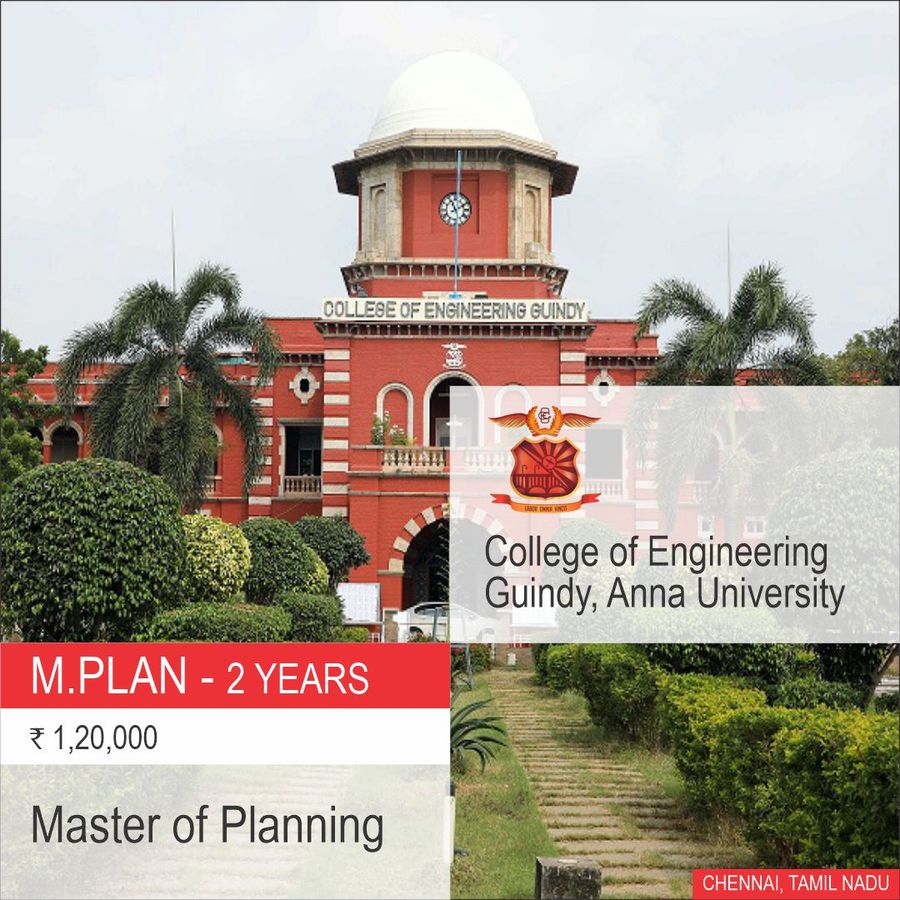


Master of Planning (M.Plan)
Architecture & Planning (M.Planning)
Shortlisted by 64+ Students
Location: Chennai
Duration: 2 YEAR
Regular / Offline
Average Fees: ₹ 1.20 Lakhs
Highlights A Master of Planning (M.Plan) is a postgraduate academic degree program focused on urban and regional planning. It is designed to equip students with the knowledge and skills necessary to address complex issues related to land use, infrastructure development, environmental sustainability, and community development. The program typically covers a range of subjects, including urban design, transportation planning, housing, environmental planning, and policy analysis. Graduates of a Master of Planning program are prepared for careers in urban planning departments, government agencies, private consulting firms, non-profit organizations, and research institutions. The curriculum often includes a combination of theoretical coursework, practical exercises, and research projects, allowing students to gain a comprehensive understanding of the challenges and opportunities in urban and regional planning. Additionally, students may have the opportunity to specialize in specific areas of planning based on their interests and career goals.




![Bachelor of Architecture [B.Arch] at IIT Roorkee - Indian Institute of Technology, Roorkee](https://promilo-prod.s3.ap-south-1.amazonaws.com/IIT Roorkee - Indian Institute of Technology/logo/logo.png)



![Bachelor of Architecture [B.Arch] at IIEST Shibpur - Indian Institute of Engineering Science And Technology, West Bengal - Other](https://promilo-prod.s3.ap-south-1.amazonaws.com/IIEST Shibpur - Indian Institute of Engineering Science And Technology /logo/logo.png)
![Bachelor of Architecture (B.Arch) at Visvesvaraya National Institute Of Technology - [VNIT], Nagpur, Nagpur](https://promilo-prod.s3.ap-south-1.amazonaws.com/campaign/2c9f8a727cc11af2017cf05599651000/campaign_image/logo.png)









![Master of Architecture [M.Arch] at College of Engineering Guindy, Anna University, Chennai](https://promilo-prod.s3.ap-south-1.amazonaws.com/College of Engineering Guindy, Anna University/logo/logo.png)


![Master of Architecture [M.Arch] at Sathyabama Institute of Science And Technology, Chennai](https://promilo-prod.s3.ap-south-1.amazonaws.com/Sathyabama Institute of Science And Technology/logo/logo.png)
![Master of Architecture [M.Arch] at College of Engineering Guindy, Anna University, Chennai](https://promilo-prod.s3.ap-south-1.amazonaws.com/College of Engineering Guindy, Anna University/logo/logo.png)
About us
CEG was established in May of 1794, as a School of Survey with one student in a building near Fort St. George. Founded by Michael Topping, the school became the Civil Engineering School in 1858. Subsequently, CEG was established as a college in 1859 under the Madras University. It was then rechristened as the College of Engineering in 1861 with the inclusion of the Mechanical Engineering course.
CEG began its journey as a school of survey established by the East India Company in 1794 at the Fort St.George, Madras. There were only eight students initially. It was started by the initiative of Michael Topping, an Astronomical Surveyor. He was succeeded by John Golding Ham, who was an Architect and Marine Surveyor. The name of the survey school was changed to Civil Engineering School and moved to the Kalasa Mahal buildings in Chepauk in 1858. The scope was to train upper and lower subordinates. The College was affiliated with the Madras University in 1862.
Civil Engineering was a much sought-after field of study, a speciality in those early days. The first set of the students received the DCE degree in 1864. In 1920, the College moved into the sprawling 185-acre campus at Guindy. In 1925, Rao Bahadur G. Nagarathinam Ayyar became the first Indian Principal of the College. This institution became the oldest technical institution in Asia and has several firsts to its credit. The shifting of the college to Guindy was the impact of conducting the Degree courses in Mechanical Engineering, and paved the way for rapid expansion to add some more Degree courses.
Approaches of M.Plan Programme
College Search Made Easy, Find the Right College for You in Minutes, Not Months!
Discover courses, internships, and jobs that sync with your goals.
Get access to premium features and connect directly with experts. You're all set!
Schedule a free online meeting or talk to experts Jump into a meeting with pro-experts. We got you!
Your time is valuable, and we appreciate every moment you spend with us. That's why we continue to reward you for your engagement.